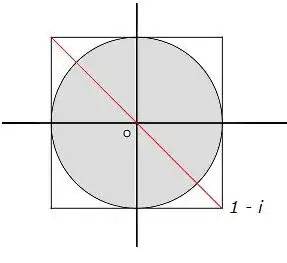I am confused about complex numbers. Does $1-i$ lie outside the unit circle? How do I show that the absolute value of $1-i$ is larger than that of $1$?
9 Answers
Let me do something very different for me. Let me give a geometric proof:
Note that $1-i$ is the bottom-right corner of the square whose center is $0$ and whose edges have length $2$. The other corners are $1+i; -1+i; -1-i$.
The diagonal running from $-1+i$ to $1-i$ is a straight line passing through $0$. Its length, by the Pythagoras theorem, is $2\sqrt2=\sqrt8$. Therefore the distance between $0$ and each of the corners is exactly half, i.e. $\sqrt2$.
And it is trivial to see that $\sqrt2>1$.
Here is a drawing:
$\hspace{5cm}$
- 8,662
- 393,674
-
32I must be very tired if I am thinking about this in terms of geometry. – Asaf Karagila Feb 25 '13 at 23:04
-
9...and now I added a drawing. The horror... (If anyone can improve this drawing somehow, please do. :-)) – Asaf Karagila Feb 25 '13 at 23:18
-
-
-
5
-
10
-
3I concur, given the lack in intuitive understanding of complex numbers the OP showed, this really is the only reasonable answer. – Christian Feb 26 '13 at 10:06
-
-
-
1@Harsh: Thanks, but I wouldn't normally have given such answer. Not geometric and not one illustrated. – Asaf Karagila Feb 26 '13 at 16:18
-
1
-
1
-
-
1@pushpen.paul: I used GIMP, and the basic geometric shapes. If you look at the history, though, you'll see that I didn't draw this image, but a much uglier one. This one was contributed by someone else with a bit more design skills than me. – Asaf Karagila Jan 11 '15 at 13:07
-
My dear Asaf: May I ask you to take a look at this answer? That is mine. Is that a wrong version? Thanks. – Mikasa Sep 14 '18 at 13:42
-
By definition, the absolute value of a given complex number $z$ with $z=x+iy$ (for some $x,y\in \Bbb R$) is $\sqrt{x^2+y^2}$ and it is denoted by $|z|$.
If $z=1-i$, according to the definition we get $|1-i|=\sqrt{1^2+(-1)^2}=\sqrt {2}>1=|1|$.
- 31,356
Hint: By definition, if $a+bi$ is a complex number ($a$ and $b$ being real numbers, as usual), $$|a+bi|=\sqrt{a^2+b^2}.$$
Also, it is really incorrect to say that "$1-i$ is larger than $1$"; the complex numbers have no ordering. You should just instead say that $|1-i|>1$.
- 129,973
In complex number, you have to compute the module of a number to say if it is "larger" than something. In general the module is $$|a+bi|=\sqrt{a^2+b^2}$$
In your case $$|1-i|=\sqrt{1^2+(-1)^2}=\sqrt{2}$$
Then $$\sqrt{2}\geq|1|$$
And this imply that $1-i$ lies outside of the unit circle
- 1,939
One of the properties of complex numbers is that we cannot compare them, but we can compare their modulus.
you can compare $|1-i|$ with $|1|$, equivalent with $\sqrt{1^{2}+1^{2}}\geq 1.$
- 6,790
$|1|= 1$
$|1-i|= \sqrt{1^2+(-1)^2}=\sqrt{2}$
Since the modulus is radius in the Argand plane,
$|1-i|>|1|$
- 7,881
This is a small variant of Asaf Karagila's geometric proof: If $a$ and $b$ are two points in the complex plane, the distance between them is $|a-b|$, so if you draw the (right isosceles) triangle with $a=1$, $b=i$ and $c=0$, you see that $|1-i|\gt1$.
- 79,832
Here is another different approach:
The unique angle (in $[0,2\pi)$) between the vector $(1,i)$ in the complex plane and the x-axis is $\phi=\frac{7\pi}{4}$
Euler's identity yields now:
$$1-i=L(e^{\frac{7\pi}{4}i})=L\left(\cos\left(\frac{7\pi}{4}\right)+i\sin\left(\frac{7\pi}{4}\right)\right)=L\left(\cos\left(-\frac{\pi}{4}\right)+i\sin\left(-\frac{\pi}{4}\right)\right)=L\left(\cos\left(\frac{\pi}{4}\right)-i\sin\left(\frac{\pi}{4}\right)\right)=L\left(\frac{1}{\sqrt{2}}-i\frac{1}{\sqrt{2}}\right) $$
Hence $L=\sqrt{2}$
- 25,026
- 3,371
- 1
- 16
- 24
|a| = sqrt(C² + R²)=>|1 - i| = sqrt(1² + 1²) = sqrt(2)and|1| = 1.sqrt(2) > 1 => |1 - i| > |1|– njzk2 Feb 26 '13 at 11:03